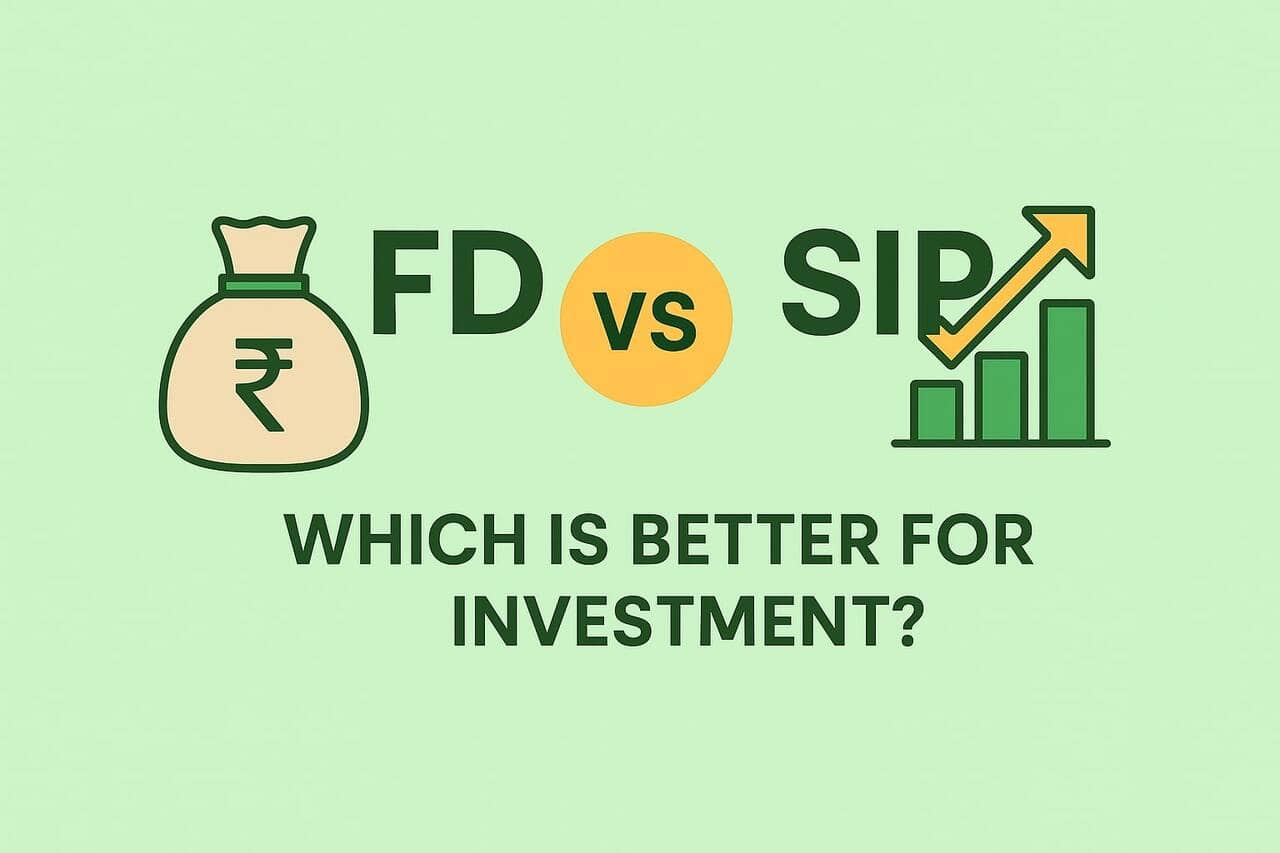When it comes to saving and investing in India, two popular options often come to mind—Fixed Deposit (FD) and Systematic Investment Plan (SIP). While both are trusted methods, they serve different purposes and come with their own set of pros and cons.
In this article, we’ll break down FD vs SIP in terms of returns, safety, liquidity, tax benefits, and long-term performance to help you make the right choice in 2025.
What is a Fixed Deposit (FD)?
An FD (Fixed Deposit) is a safe investment where you deposit a lump sum amount in a bank for a fixed period, and you earn interest at a pre-decided rate.
- Return Type: Fixed
- Risk Level: Very Low
- Tenure: 7 days to 10 years
- Interest Rate (2025 average): 6%–7.5% annually
Example:
If you invest ₹1,00,000 for 5 years at 6.5% interest, you’ll receive approximately ₹1,38,225 at maturity. The returns are fixed and guaranteed, regardless of market conditions.
Pros:
- Guaranteed returns
- Low risk
- Flexible tenure
Cons:
- Returns may not beat inflation
- Interest is fully taxable
- Penalty on premature withdrawal
What is a Systematic Investment Plan (SIP)?
Systematic Investment Plan (SIP) is a method where investors contribute a fixed sum regularly to mutual funds, allowing long-term wealth growth. This approach can be started with low amounts and provides flexibility. Unlike FDs, SIP returns are market-dependent.
- Return Type: Market-linked
- Risk Level: Low to High (depending on fund type)
- Tenure: Flexible (ideal for long-term)
- Historical Returns: 10%–15% annually (for equity funds)
Example:
Investing ₹2,000/month for 5 years at 12% average return results in approximately ₹1,62,000, while the total investment is ₹1,20,000.
Pros:
- High return potential
- Compounding and rupee cost averaging benefits
- Tax-saving options (ELSS)
Cons:
- Market-linked, hence risky
- Returns not guaranteed
- Requires long-term discipline
FD vs SIP: Quick Comparison Table
| Feature | FD (Fixed Deposit) | SIP (Mutual Fund) |
|---|---|---|
| Returns | Fixed (6–7%) | Variable (10–14%) |
| Risk | Very Low | Moderate to High |
| Tenure | Fixed term | Flexible (any time) |
| Tax | Interest fully taxable | LTCG @12.5% if gains > ₹1.25L/year |
| Liquidity | Medium (penalty on exit) | High (open-ended funds) |
| Best For | Short-term, risk-averse | Long-term, goal-based investing |
Real-Life Example: FD vs SIP in 5 Years
| Details | FD Investment | SIP Investment |
|---|---|---|
| Amount | ₹1,00,000 (lump sum) | ₹2,000/month = ₹1,20,000 |
| Tenure | 5 years | 5 years |
| Rate/Return | 6.5% fixed | 12% average |
| Maturity Amount | ₹1,38,225 | ₹1,62,000 (approx.) |
| Tax Impact | Interest fully taxable | LTCG @12.5% if gains > ₹1.25L/year |
Which One is Better in 2025?
Choose FD if:
- You need guaranteed returns.
- Your investment horizon is short (less than 3 years).
- You’re risk-averse and want capital protection.
- You are a senior citizen looking for fixed income.
Choose SIP if:
- You are investing for long-term goals (5+ years).
- You want to beat inflation and grow wealth.
- You can tolerate short-term market volatility.
- You want to start with as low as ₹500/month.
Tax Angle: FD vs SIP
FD Interest: Fully taxable as per income slab.
SIP Returns: If held for less than 1 year, Short-Term Capital Gains (STCG) are taxed at 15%. If held for more than 1 year, Long-Term Capital Gains (LTCG) are tax-free up to ₹1.25L/year. Beyond this limit, a 12.5% tax applies.
Conclusion: FD vs SIP – Who Wins?
If safety and fixed returns are your top priority, go with FDs. But if your goal is to grow wealth over time and beat inflation, SIPs are the clear winner—especially in 2025, when market participation is growing and digital access to mutual funds is easier than ever.
Tip: It’s always a good idea to consult with a financial advisor to tailor your investment strategy to your specific goals and risk tolerance.
Frequently Asked Questions (FAQs)
An FD (Fixed Deposit) is a one-time investment with a fixed interest rate and tenure, offering guaranteed returns. In contrast, a SIP (Systematic Investment Plan) involves regular investments in mutual funds, with returns subject to market performance.
FDs are considered safer as they offer fixed returns and are not subject to market risks. SIPs, while potentially offering higher returns, carry market-related risks.
Yes, premature withdrawal is possible in both. However, FDs may incur a penalty for early withdrawal, whereas SIPs offer more flexibility, though it's advisable to stay invested for the long term to maximize returns.
Interest from FDs is fully taxable as per your income slab. SIPs, particularly equity mutual funds, attract a 12.5% tax on long-term capital gains exceeding ₹1.25 lakh in a financial year.
For long-term wealth creation, SIPs are generally more beneficial due to the power of compounding and potential for higher returns, despite market risks. FDs are more suited for short-term goals and capital preservation.





